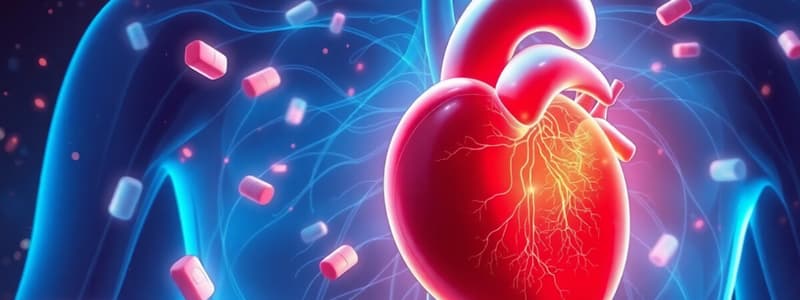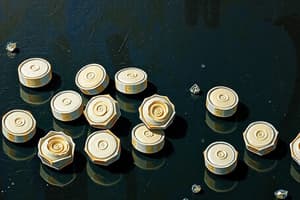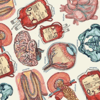Podcast
Questions and Answers
What is the primary mechanism by which nitrates alleviate angina symptoms?
What is the primary mechanism by which nitrates alleviate angina symptoms?
Nitrates are converted to nitric oxide, which relaxes smooth muscle, leading to vasodilation and reduced cardiac workload.
Explain why sublingual administration of nitrates is preferred over oral administration for acute angina relief.
Explain why sublingual administration of nitrates is preferred over oral administration for acute angina relief.
Sublingual administration bypasses the hepatic first-pass effect, allowing more of the drug to enter the systemic circulation rapidly.
How do beta-blockers contribute to the management of anginal pain?
How do beta-blockers contribute to the management of anginal pain?
Beta-blockers reduce heart rate and contractility, decreasing myocardial oxygen demand, and improving exercise tolerance.
Describe the role of calcium channel blockers in treating angina pectoris, focusing on their mechanism of action.
Describe the role of calcium channel blockers in treating angina pectoris, focusing on their mechanism of action.
What is the rationale behind using nitrates in the treatment of heart failure, considering their effects on preload and afterload?
What is the rationale behind using nitrates in the treatment of heart failure, considering their effects on preload and afterload?
Explain why tolerance can develop with long-term nitrate use and suggest a strategy to minimize this effect.
Explain why tolerance can develop with long-term nitrate use and suggest a strategy to minimize this effect.
How does Prinzmetal's angina differ pathophysiologically from typical exertional angina, and how does this influence treatment strategies?
How does Prinzmetal's angina differ pathophysiologically from typical exertional angina, and how does this influence treatment strategies?
Describe the mechanism by which ranolazine is thought to reduce anginal symptoms without significantly affecting heart rate or blood pressure.
Describe the mechanism by which ranolazine is thought to reduce anginal symptoms without significantly affecting heart rate or blood pressure.
How are nitrates used to manage acute hypertension?
How are nitrates used to manage acute hypertension?
Explain why nitrates can sometimes cause headaches as a side effect.
Explain why nitrates can sometimes cause headaches as a side effect.
Discuss the implications of administering glyceryl trinitrate orally versus sublingually on its bioavailability and therapeutic effect. Why does the route of administration matter?
Discuss the implications of administering glyceryl trinitrate orally versus sublingually on its bioavailability and therapeutic effect. Why does the route of administration matter?
In the context of antianginal drugs, what is the significance of 'myocardial ischemia', and how do different classes of these drugs address it?
In the context of antianginal drugs, what is the significance of 'myocardial ischemia', and how do different classes of these drugs address it?
How does severe left ventricular hypertrophy contribute to angina, even in the absence of atherosclerotic narrowing?
How does severe left ventricular hypertrophy contribute to angina, even in the absence of atherosclerotic narrowing?
What are the two main components that explain the mechanism of angina?
What are the two main components that explain the mechanism of angina?
How do the effects of Amyl Nitrite differ from those of Glycerine Trinitrate?
How do the effects of Amyl Nitrite differ from those of Glycerine Trinitrate?
Flashcards
What is Angina Pectoris?
What is Angina Pectoris?
Chest pain caused by reduced blood flow to the heart.
What is Atherosclerosis?
What is Atherosclerosis?
Narrowing of the arteries due to plaque buildup.
What are Antianginal drugs?
What are Antianginal drugs?
Drugs used to treat chest pain (angina) by improving blood flow.
What are Nitrovasodilators?
What are Nitrovasodilators?
Signup and view all the flashcards
What are Nitrites?
What are Nitrites?
Signup and view all the flashcards
What are Nitrates?
What are Nitrates?
Signup and view all the flashcards
What is Sublingual administration?
What is Sublingual administration?
Signup and view all the flashcards
What are Calcium Channel Blockers?
What are Calcium Channel Blockers?
Signup and view all the flashcards
What are Beta-Blockers?
What are Beta-Blockers?
Signup and view all the flashcards
What does Nitrate do?
What does Nitrate do?
Signup and view all the flashcards
What are common side effects of nitrates?
What are common side effects of nitrates?
Signup and view all the flashcards
How are organic nitrates metabolized?
How are organic nitrates metabolized?
Signup and view all the flashcards
Three purposes of nitrates?
Three purposes of nitrates?
Signup and view all the flashcards
What are the clinical uses of nitrates?
What are the clinical uses of nitrates?
Signup and view all the flashcards
Study Notes
- Antianginal medications used to treat angina pectoris
- Angina, or chest pain, is a common condition that primarily affects middle-aged individuals
- Angina treatment involves medication and the mitigation of risk factors
Causes of Angina
- Angina can be caused by the narrowing of epicardial arteries, also known as atherosclerosis
- Prinzmetal's angina occurs when epicardial arteries undergo spasms, leading to myocardial ischemia
- Severe left ventricular hypertrophy can cause angina when the hypertrophied myocardium's demand exceeds coronary supply, despite no atherosclerotic narrowing
- Angina can also be caused by myocardial cells developing ischemia, resulting in chest pain
- Angina arises from an imbalance between the heart's oxygen demand and the oxygen supply via coronary blood flow
- Atherosclerosis involves the deposition of fatty materials beneath the endothelium
- Stenosis refers to the narrowing of the arterial lumen
Pharmacotherapy of Atherosclerotic Angina
- Antianginal drugs include nitrovasodilators, Ca++ channel blockers, and β-blockers
- Nitrovasodilators include nitrites, such as amyl nitrites, and nitrates, such as glycerine trinitrate and isosorbide dinitrate
- Currently, only nitrates are used
- A considerable proportion of nitrates is lost during oral absorption due to the hepatic first-pass effect
- The sublingual route is commonly used to avoid the hepatic first-pass effect
- Nitrates can also be applied over the skin
Antianginal Drugs
- Nitrovasodilators include:
- Nitrites, such as amyl nitrite
- Nitrates, such as glycerine trinitrate, isosorbide dinitrate, and mononitrate
- Ca++ Channel Blockers include:
- Verapamil
- Dihydropyridines like nifedipine
- Amylodipine
- Diltiazem
- Beta Blockers include:
- Non-specific like propanolol
- Cardio-selective E β1-blockers like atenolol
- K+ Channel Openers include:
- Nicorandil
- Repace H.50mg
- Cytoprotective agents include:
- Trimetazidine
Nitrates
- Organic nitrates are rapidly metabolized in the liver by glutathione organic nitrate reductase, producing nitrite ions that relax smooth muscle
- Nitrates can be used as antianginal drugs
- To abort an attack, short-acting nitrates are administered sublingually
- To prevent angina from anticipated stress, short-acting nitrates are used sublingually
- For long-term prophylaxis, the drug is used routinely, such as three times a day
Clinical Uses of Nitrates
- Angina pectoris
- Heart failure
- Acute hypertension
- Myocardial infarction
Side Effects of Nitrates
- Headache
- Flushing of the face
The Nitrates
- Include amyl nitrite and glyceryl trinitrate
- Vasodilators
- Organic nitrates are rapidly metabolized in the liver by glutathione organic nitrate reductase to form nitrite oxide
- Nitrite oxide relaxes smooth muscles
- Relaxation affects all smooth muscles regardless of innervation or responses to various agonists
Experiment: Glyceryl Trinitrate and Amyl Nitrate in Man
- Divide into two groups
- Determine who can measure systolic and diastolic blood pressure and pulse rate
Glyceryl Trinitrate Procedure
- Select one subject from each group
- Measure systolic and diastolic blood pressure and heart rate every 3 minutes after the subject has been seated for 5-10 minutes
- Obtain a series of constant control values before proceeding
Volunteer Subject 1
- Administer 1mg of glyceryl trinitrate sublingually
- Continue taking readings every 3 minutes for an additional half hour
- The subject should chew the tablet and retain debris under the tongue (and saliva in the mouth) for about 5 minutes
Volunteer Subject 2
- Administer 1mg of glyceryl trinitrate orally by swallowing the tablet whole without chewing
- Continue taking the readings as above
- Plot the results against time
- Include both subjects on the same graph paper and compare the changes
Studying That Suits You
Use AI to generate personalized quizzes and flashcards to suit your learning preferences.





